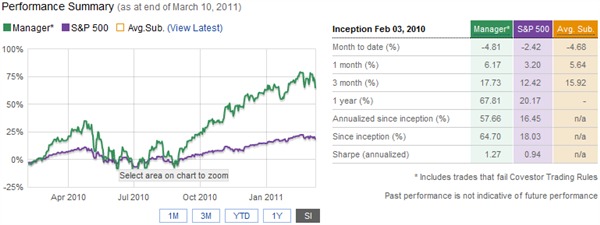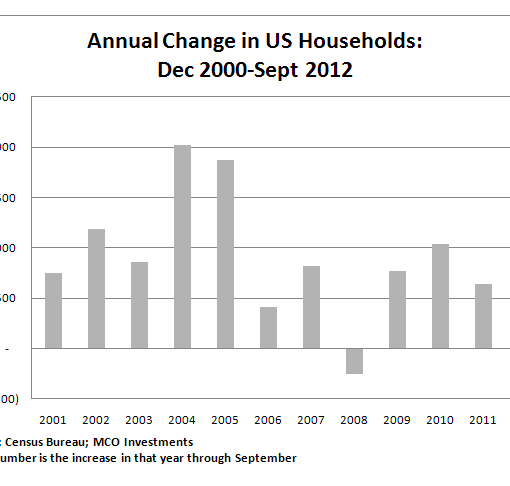 Author: Mark Holder
Author: Mark Holder
Covestor model: Opportunistic Arbitrage
Disclosure: Long FCX, IBN, CCIH, RDWR, ATW, SHLD, PUDA, CEPH, MEE, ANR
After a disappointing January, February was a welcome return to outperforming the market. The model returned approximately 3% greater than the S&P500. The market remained strong even in the face of Middle East turmoil and continuous calls that it is overbought. Investors need to consider that corporate profits are returning to around the peak levels of 2007, while the S&P500 remains well below its all time high from late 2007. In that context, the market appears cheap and would seem to have plenty of room still to run.
I am definitely cognizant that the market needs a breather or even a minor 5% or so correction, though market participants need to understand that even a 10% correction from late February 2011 highs would leave the market close to 1,200. That’s a level some 25% below the peak back in 2007 even as the corporate profit levels reach back to their highs.
Added Long Exposure
In that context, with corporate profits soaring and the market appearing extremely cheap, this model used the late February weakness to add back long exposure. Freeport McMoRan Copper & Gold (FCX) was added back to the model while three new stocks were added: ICICI Bank (IBN), ChinaCache (CCIH), and Radware (RDWR). The main theme of adding FCX, IBN, and CCIH was to increase exposure to the emerging markets. Exposure had been reduced to the sector over the last few months as it has fallen out of favor. By February valuations had become too inexpensive to pass up with all three stocks down significantly from recent highs. CCIH was down approximately 50% from its highs reached after its very successful IPO, so it appeared to me a bargain
RDWR, on the other hand, was added to gain more exposure to the fast-growing network and cloud computing space. The main thrust of the trade was to add back exposure after selling Terremark Worldwide (TMRK) in January, following its purchase by Verizon Communications (VZ).
Top Performers
Ironically the top performer was a stock just added towards the end of the month. CCIH had a strong gain in less then a week. CCIH is the Akamai (AKAM) of China and has enormous potential but the departure of the COO has placed the future in doubt, providing an opportune entry point. Also, after a weak few months, China markets have started to heat up, providing for an attractive entry point to U.S.-listed China stocks at their lows. Most market commentators have apparently missed the run up as the focus remains on the violence in Libya and potential protests in oil rich Saudi Arabia.
Two tech stocks in the model had good months. Even with the chorus mostly claiming that tech was overbought and expensive, Riverbed Tech (RVBD) enjoyed a strong gain and Limelight Networks (LLNW) was also up.
The other top 5 performers were Atwoods Oceanics (ATW) and Sears Holdings (SHLD). ATW is a deepwater driller, so it’s not too surprising that it had a good month with oil spiking and the prospects for drilling offshore much more attractive now that the investment community has been reminded that risks of an accident on an oil rig can be less than the political stability in most oil producing countries.
Bottom Performers
AerCap Holdings (AER) had the worst month of any position in the model, as the airplane lessor was impacted by the spiraling costs of oil and the fears of reduced travel demands. Although AER isn’t nearly as impacted as the market always believes, the stock tends to trade violently during these time periods. The company has extremely long leases with a diverse group of airlines and the continual increase in demand for global travel tends to override these minor setbacks. AER also has a relatively young fleet of fuel efficient planes that are in higher demand as oil prices rise. The company survived the financial crisis with minimal impact, so I am not so quick to sell this stock.
The remaining weak performers were mostly due to concerns over higher inflation in emerging markets or a reduction of work form the turmoil in the Middle East. Puda Coal (PUDA), Cephalon (CEPH), and ICICI Bank (IBN) were all down.
Largest Position
The combination of Massey Energy (MEE) and Alpha Natural Resources (ANR) remains the largest position in the model by far. MEE alone has the largest weighting at 9.48% as of end of day 3/7/11. Over time I expect this combined position will be reduced as the model aims to keep all positions below 10%. The significant drop of ANR following the mostly stock buyout agreement with MEE lead to the decision to keep both stocks for now. Metallurgical coal remains in high demand due to emerging market growth and reduced supplies because of the Australia floods. The ANR/MEE combination makes for a global powerhouse in the met coal area and a very attractive investment option. Regardless, some stock will be sold into strength to reduce exposure.
Conclusion
The market began March with numerous concerns and some relative weakness, providing a number of opportunities. Investors in general continue to focus too much on the returns off the market bottom two years ago and not enough on the returns since the market top less then four years ago. The market remains long term bullish when looking at the complete picture as opposed to chopping off a small corner to fit an investment thesis.
Sources:
“You Think A Booming Economy Is Good For The Stock Market? Think Again…” John Mauldin. Business Insider, 3/5/11. https://www.businessinsider.com/is-a-booming-economy-even-good-for-the-stock-market-2011-3?r=US&IR=T
All pricing information sourced from Yahoo Finance, http://finance.yahoo.com


